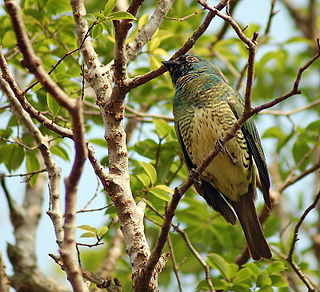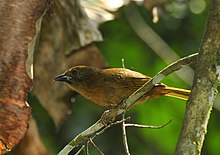
The bluish-grey saltator or Amazonian grey saltator is a passerine bird in the tanager family Thraupidae that is widespread in semi-open habitats in tropical and subtropical South America.

The plain-brown woodcreeper, is a sub-oscine passerine bird in subfamily Dendrocolaptinae of the ovenbird family Furnariidae. It is found in the tropical New World from Honduras through South America to central Brazil and in Trinidad and Tobago.

The white hawk is a bird of prey breeding in the tropical New World of the family Accipitridae. Though it is commonly placed in the subfamily Buteoninae, the validity of this group is doubtful and currently under review.

The blue-black grassquit is a small Neotropical bird in the tanager family, Thraupidae. It is the only member of the genus Volatinia. It is a common and widespread bird that breeds from southern Mexico through Central America, and South America as far as northern Chile, Argentina, and Paraguay, and in Trinidad and Tobago. A male was also observed in Graham County, Arizona on July 15 and July 17, 2023.

The olivaceous woodcreeper is a passerine bird in subfamily Dendrocolaptinae of the ovenbird family Furnariidae. It is found from central Mexico south through every Central American country, on the island of Tobago, and in every mainland South American country except Chile, French Guiana, and Suriname.

The white-throated spadebill is a tiny passerine bird in the tyrant flycatcher family. It lives in the tropical Americas.

The saffron finch is a tanager from South America that is common in open and semi-open areas in lowlands outside the Amazon Basin. They have a wide distribution in Colombia, northern Venezuela, western Ecuador, western Peru, eastern and southern Brazil, Bolivia, Paraguay, Uruguay, northern Argentina, and Trinidad and Tobago. It has also been introduced to Hawaii, Panama, Puerto Rico and elsewhere. Although commonly regarded as a canary, it is not related to the Atlantic canary. Formerly, it was placed in the Emberizidae but it is close to the seedeaters.

The red-billed pied tanager is a species of bird in the family Mitrospingidae. It is found in Bolivia, Brazil, French Guiana, Guyana, Peru and Suriname. Placed in family Thraupidae, the "true" tanagers, for over two centuries, the International Ornithological Committee reclassified this species to Mitrospingidae in 2018.

The red-throated ant tanager is a medium-sized passerine bird. This species is a resident breeder on the Caribbean slopes from southeastern Mexico to eastern Panama. It was formerly placed with the red-crowned ant tanager in the genus Habia. It was usually considered an aberrant kind of tanager and placed in the Thraupidae, but is actually closer to the cardinals (Cardinalidae). Consequently, it can be argued that referring to the members of this genus as ant tanagers is misleading, but no other common name has gained usage.

The squirrel cuckoo is a large and active species of cuckoo found in wooded habitats from northwestern Mexico to northern Argentina and Uruguay, and on Trinidad. Some authorities have split off the western Mexican form as the Mexican squirrel-cuckoo.

The hepatic tanager is a medium-sized American songbird. Formerly placed in the tanager family (Thraupidae), it and other members of the genus Piranga are now classified in the cardinal family (Cardinalidae).

The black-goggled tanager is a species of bird in the family Thraupidae. It is the only member of the genus Trichothraupis. It is found at low levels in forest and woodland in a large part of eastern and southern Brazil, eastern Paraguay, and far north-eastern Argentina, with a disjunct population along the East Andean slope in Peru, Bolivia, and far north-western Argentina. While generally common and widespread, and consequently considered to be of least concern by BirdLife International and IUCN, the population associated with the Andes is relatively local and uncommon.

The fawn-breasted tanager is a species of tanager with a blue head and yellow breast. It occurs in the Andes of northwestern Argentina, Bolivia, Colombia, Ecuador, Peru, and Venezuela, as well as in the highlands of northeastern Argentina, south Brazil, Paraguay, and Uruguay.

The swallow tanager is a species of Neotropic bird in the tanager family Thraupidae. It is the only member of the genus Tersina. It is found widely throughout South America, from eastern Panama to far northern Argentina. The species is sexually dimorphic: the female is a yellow-green and the male a turquoise blue with a small deep black face and upper throat patch.

The grey-headed tanager is a widely distributed species of small Neotropical bird in the tanager family Thraupidae. It is the only member of the genus Eucometis.

The guira tanager is a species of bird in the family Thraupidae.

The hooded tanager is a species of bird in the tanager family Thraupidae. It is found in Argentina, Bolivia, Brazil, Colombia, French Guiana, Guyana, Paraguay, Peru, and Venezuela. Its natural habitats are subtropical or tropical moist lowland forest, subtropical or tropical mangrove forest, and heavily degraded former forest.

The burnished-buff tanager, also known as the rufous-crowned tanager, is a common South American species of bird in the family Thraupidae.

The azure-shouldered tanager is a species of bird in the tanager family, Thraupidae. Described by the French zoologist Louis Pierre Vieillot in 1817, it is only found in the Atlantic Forest of southeastern Brazil, from southeastern Bahia, eastern Minas Gerais, and Espírito Santo south to northern Rio Grande do Sul. It inhabits humid montane forests, open woodlands, secondary growth, and forest edges and can be found at elevations of up to 1,600 m (5,200 ft), but usually stays below 1,200 m (3,900 ft).

Cymbopetalum mayanum is a species of plant in family Annonaceae. The specific epithet mayanum refers to the Mayan region in which it is indigenous, specifically the Atlantic lowlands of Guatemala and Honduras. It grows as a tree. It is endangered due to habitat loss from agriculture.























